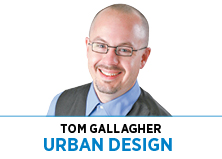Subscriber Benefit
As a subscriber you can listen to articles at work, in the car, or while you work out. Subscribe Now I must confess my disappointment in the system-level analysis the Indiana Department of Transportation recently released for the controversial downtown Inner Loop project. I had hoped INDOT would embrace what we’ve learned from 70 years of experience with limited-access highways and help us arrive at solutions that position us for the 21st century. It is not entirely clear to me what the ultimate answer should be, but I know the opportunity deserves more scrutiny. Here are a few broad topics worth considering:
I must confess my disappointment in the system-level analysis the Indiana Department of Transportation recently released for the controversial downtown Inner Loop project. I had hoped INDOT would embrace what we’ve learned from 70 years of experience with limited-access highways and help us arrive at solutions that position us for the 21st century. It is not entirely clear to me what the ultimate answer should be, but I know the opportunity deserves more scrutiny. Here are a few broad topics worth considering:
Congestion
◗ There is no such thing as “zero congestion.” We cannot completely rid ourselves of traffic delays during peak drive times, but it is certainly fair to consider a course of action when congestion becomes severe. On the opening page of the Inner Loop project website, INDOT states that the north split is “one of Indiana’s most congested interchanges.” While this might be the case, the Indianapolis metro area is one of the least congested in North America.
In global navigation company TomTom’s worldwide traffic congestion index, Indy ranks third-best among nearly 200 cities with populations of at least 800,000. The index says Indy drivers experience about 15 minutes of delay per day (about eight minutes during each peak). Though not as plainly stated, the numbers in INDOT’s analysis appear to suggest the same.
◗ Adding lanes does not solve congestion. It is true that there might be a short period of improvement immediately after a road is widened, but the improvement itself soon leads to more congestion. The less-congested road draws more drivers until capacity is exceeded again.
The Katy Freeway in Houston claimed the title of world’s widest highway, weighing in at 26 lanes, when it was built for $2.8 billion in 2011 to counter growing congestion in the region. By 2014, the Katy was experiencing more congestion than it had in 2011 by 30 percent in the morning and 55 percent in the afternoon.
◗ Economic success and traffic volumes are not proportionally related. According to the Federal Bureau of Economic Analysis, the Indy metro area, from 2001 to 2015, experienced an increase in population of 300,000 people, improved total employment by more than 15 percent, and saw gross domestic product rise 70 percent. The TomTom Traffic Index indicates the level of congestion has remained essentially unchanged over a similar period.
◗ Drivers are pliable. Traditional traffic models have a hard time accounting for human resourcefulness. In other cities where urban freeways have been decommissioned, drivers have effectively taken advantage of alternative routes. We need to recognize that the whole urban network of roads works together as a system. If the urban grid of streets is allowed to function at its best, few things are more efficient.
Consider the 2004 Purdue study of the Hyperfix Project, a weeks-long shutdown of the downtown interstate in 2003 that allowed for repaving and other modifications. During Hyperfix, most surface roads saw an increase in vehicles, but delays were “observed to be relatively minor,” the worst of which ranged from “24 seconds to 195 seconds.” The study states, “Commuters felt that the project did not significantly affect travel into the downtown area. Because alternate routes were available, the majority of riders took them.”
Land value
The diminished value of real estate adjacent to a highway is permanent. Our historic urban neighborhoods have come a long way in 50 years, mitigating the negative effects of the Inner Loop. The reality, however, is that, while the highway exists, the adjoining properties will not increase in value at the same rate as similar ones blocks away. In contrast, a different kind of infrastructure can instigate higher adjacent values, like the 22 percent premium seen in Chicago along the 606 Trail or the improvement in property values along the Cultural Trail here in Indy.
Equity
Highways, by their nature, are inequitable. There is a simple graphic under the Environmental Justice tab of INDOT’s North Split website that illustrates how the same resources, used conscientiously, can provide greater opportunity for all. Yet, highways, by design, must be exclusionary. Biking and walking are prohibited, and one must be able to afford a car to take part in the benefits.
One thing we can be sure of, given the state of the aging infrastructure and the inadequacies of its original design, we will need to spend significantly on whatever comes next. In spite of the cost, this should be seen as an opportunity.
Since the Inner Loop was completed five decades ago, phones have gone from rotary to having more computing capacity than NASA had for the Apollo missions. Surely our transportation leaders can find a way forward that matches mobility with our changed populace, optimism for urban living and desire for social justice.•
__________
Gallagher is a principal and urban designer with Ratio and a professor-in-practice of urban design at Ball State University. Send correspondence to [email protected].
Please enable JavaScript to view this content.
